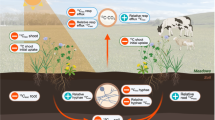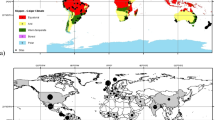Abstract
The effect of tree canopy on the growth, productivity and forage quality of Megathyrsus maximus and changes in soil properties were evaluated over three seasonal periods. Four adjacent plots (15 m × 17 m each) in a tropical secondary deciduous forest having 12 years of growth and dominated by Gliricidia sepium were randomly assigned to two treatments: removal of trees (SCA) in two of the plots and leaving trees intact (COA) in the other two. In all plots, M. maximus was planted with 50 cm spacing among plants. Tree removal significantly increased the incident photosynthetically active radiation (PAR, P < 0.001) and grass size (12.5 % in height, P < 0.01, and 16.5 % in clump diameter, P < 0.05), but did not significantly affect any other variable. Season significantly affected grass height (P < 0.003), tiller number (P < 0.001), clump diameter (P < 0.001), net CO2 assimilation rate (P < 0.001), forage biomass production (P < 0.003), and acid detergent fiber content (P = 0.033). Primary soil changes after 1 year of establishment of the grass were the decline by 3 % in organic carbon (P = 0.03), and qualitative changes in soil structure, regardless of tree presence. Results are consistent with the ability of M. maximus to tolerate shade. We conclude that under the conditions of the study there was no evidence for a negative effect of tree canopy on M. maximus mediated by a reduction in PAR.



Similar content being viewed by others
References
Andrade HJ, Ibrahim M, Jiménez F, Finegan B, Kass B (1999) Dinámica productiva de sistemas silvopastoriles con Acacia manginum y Eucalyptus deglupta en el trópico húmedo. Agroforestería en las Américas 6:48–50
Andrade HJ, Esquivel H, Ibrahim M (2008) Disponibilidad de forrajes en sistemas silvopastoriles con especies arbóreas nativas en el trópico seco de Costa Rica. Zootecnia Trop 26:289–292
ANKOM Technology (2010) Instrument manuals. http://www.ankom.com/instrument-manuals.aspx. Accessed 22 Feb 2012
AOAC (1980) Official method 4.2.11 protein (crude) in animal feeds, forage (plant tissue), grain, and oilseeds. In: C Vanderzant and DF Splittstoesser (eds) Official methods of analysis of AOAC international, 13th edn. Washington DC, AOAC International
Bautista-Tolentino M, López-Ortiz S, Pérez-Hernández P, Vargas-Mendoza MC, Gallardo-López F (2011) Productividad forrajera de agroecosistemas con bovinos bajo pastoreo tradicional y dirigido en Paso de Ovejas, Veracruz, México. Trop Subtrop Agroecosyst 13:279–290
Belsky AJ (1994) Influences of trees on savanna productivity: tests of shade, nutrients, and tree–grass competition. Ecology 75:922–932
Bolívar DM, Ibrahim M, Kass D, Jiménez F, Camargo CJ (1999) Productividad y calidad forrajera de Brachiaria humidicola en monocultivo y en asocio con Acacia mangium en un suelo ácido en el trópico húmedo. Agroforestería en las Américas 6:48–50
Bullock P, Fedoroff N, Jongerius A, Stoops G, Tursina T (1985) Handbook for soil thin section description. Wayne Research Publications, Wolverhampton
Callaway RM (1994) Facilitative and interfering effects of Arthrocnemum subterminale on winter annuals. Ecology 75:681–686
Callaway RM (1995) Positive interactions among plants. Bot Rev 61:306–349
Callaway RM, Walker RL (1997) Competition and facilitation: a synthetic approach to interactions in plant communities. Ecology 78:1958–1965
Casanova F, Ramírez L, Solorio F (2007) Interacciones radiculares en sistemas agroforestales: mecanismos y opciones de manejo. Avances en Investigación Agropecuaria 11:41–52
Columbe CE (2000) Vertisols. In: Summer M (ed) Handbook of soil science. CRC, Washington DC, pp E269–E286
de Soares AC, Freira JMV, Costa JC, Alexandre FV (2004) Crescimiento de gramíneas e leguminosas forrageiras tropicais sob sombreamento. Pesqui Agropecu Bras 39:263–270
Dohn J, Dembelé F, Karembé M, Moustakas A, Amévor KA, Hanan NP (2013) Tree effects on grass in savannas: competition, facilitation and the stress-gradient hypothesis. J Ecol 101:202–209
García E (1973) Modificaciones al sistema de clasificación climática de Köppen. Universidad Nacional Autónoma de México, Mexico City
Gotelli NJ, Ellison AM (2004) A primer of ecological statistics. Sinauer, Sunderland
Humphreys LR (1991) Tropical pasture utilization. Cambridge University Press, Cambridge
INIFAP-CONABIO (1995) Edafología. Escala 1:250 000y 1:1000000 México. En: Sistema de Informacion Biotica © 5.0. Instituto Nacional de Investigaciones Forestales Agrícolas y Pecuarias-Comisión Nacional para el Conocimiento y Uso de la Biodiversidad, México D.F, México. www.conabio.gob.mx/biotica5/documents/Descargabiotica.php. Accessed 22 Oct 2012
Kitzberger T, Steinaker FD, Veblen TT (2000) Effects of climatic variability on facilitation of tree establishment in Northern Patagonia. Ecology 81:1914–1924
López CCJ (2008) Uso actual, potencial y clasificación campesina de tierras agrícolas en la comunidad de Angostillo, municipio de Paso de Ovejas, Veracruz, México. Reporte Técnico, Colegio de Postgraduados, México
Maestre FT, Bautista S, Cortina J (2003) Positive, negative, and net effects in grass-shrub interactions in Mediterranean semiarid grasslands. Ecology 84:3186–3197
Navas AP (2003) Influencia de la cobertura arbórea de sistemas silvopastoriles en la distribución de garrapatas en fincas ganaderas en el bosque seco tropical. M.Sc. thesis, Centro Agronómico Tropical de Investigación y Enseñanza, Turrialba, Costa Rica
Obispo NE, Espinoza Y, Gil JL, Ovalles F, Rodríguez MF (2008) Efecto del sombreado sobre la producción y calidad del pasto guinea Panicum maximum en un sistema silvopastoril. Zootecnia Trop 26:285–288
Pape T, Lagger D (1995) Manual for soil description and classification. Department of Soil Science and Geology, Wageningen Agricultural University, Wageningen, Netherlands
R (2012) The R Foundation for Statistical Computing. www.r-project.org. Accessed 30 Oct 2012
Renolfi RF, Fumagalli EA (1998) Producción de forraje y carne en un bosque de la región chaqueña occidental bajo manejo silvopastoril. Revista Argentina de Producción Animal 18:231–232
Sánchez HR, Ordaz CM, Benedicto VGS, Hidalgo MCI, Palma LDJ (2005) Cambios en las propiedades físicas en un suelo arcilloso por aporte de lombricompuesto de cachaza y estiércol. Interciencia 30:775–779
SAS (2010) Statistical Analysis System, enterprise guide v 4.3.0. SAS Institute, Inc., Cary, New Jersey, USA
Shepherd TG, Saggar RS, Newman CH, Ross W, Dando LJ (2001) Tillage-induced changes to soil structure and organic carbon fraction in New Zealand soils. Aust J Soil Res 39:465–489
Shibu J (2012) Agroforestry for conserving and enhancing biodiversity. Agrofor Syst 85:1–8
Stoops G (2007) Micromorphology in soils derived from volcanic ash in Europe. A review and synthesis. Eur J Soil Sci 58:356–377
Van Reeuwijk LP (2000) Procedimientos para análisis de suelos. Traducción al español por Gutiérrez CMC, Taravez ECCA, y Ortiz SCA. Colegio de Postgraduados, Montecillo
Viáfara B, Clavero T, Araujo OF (1997) Efecto del sombreamiento de samán (Pithecellobium saman Jacq. (Benth)), sobre el crecimiento y desarrollo del pasto guinea (Panicum maximum Jacq.). Arch Latinoam Prod Anim 5:39–41
Wilding LP, Oleschko K (1994) Micromorphological indicators of anthropogenic effects on soils. Congr Soil Sci 6:205–223
Acknowledgments
This research was funded in part by the Fideicomiso Revocable de Administración e Inversión No. 167304, para el establecimiento y operación de los fondos para la investigación científica y desarrollo tecnológico del Centro Público Colegio de Postgraduados. Funding was also provided by the LPI2 Agroecosistemas Sustentables of Colegio de Postgraduados. The CONACyT granted a M.Sc. scholarship to Lucero Medinilla Salinas. Pedro F. Quintana-Ascencio wrote the R-code for the statistical analysis of PAR. Thanks to Humberto Dominguez for allowing us to study his land.
Author information
Authors and Affiliations
Corresponding author
Rights and permissions
About this article
Cite this article
Medinilla-Salinas, L., Vargas-Mendoza, M.d.C., López-Ortiz, S. et al. Growth, productivity and quality of Megathyrsus maximus under cover from Gliricidia sepium . Agroforest Syst 87, 891–899 (2013). https://doi.org/10.1007/s10457-013-9605-1
Received:
Accepted:
Published:
Issue Date:
DOI: https://doi.org/10.1007/s10457-013-9605-1




